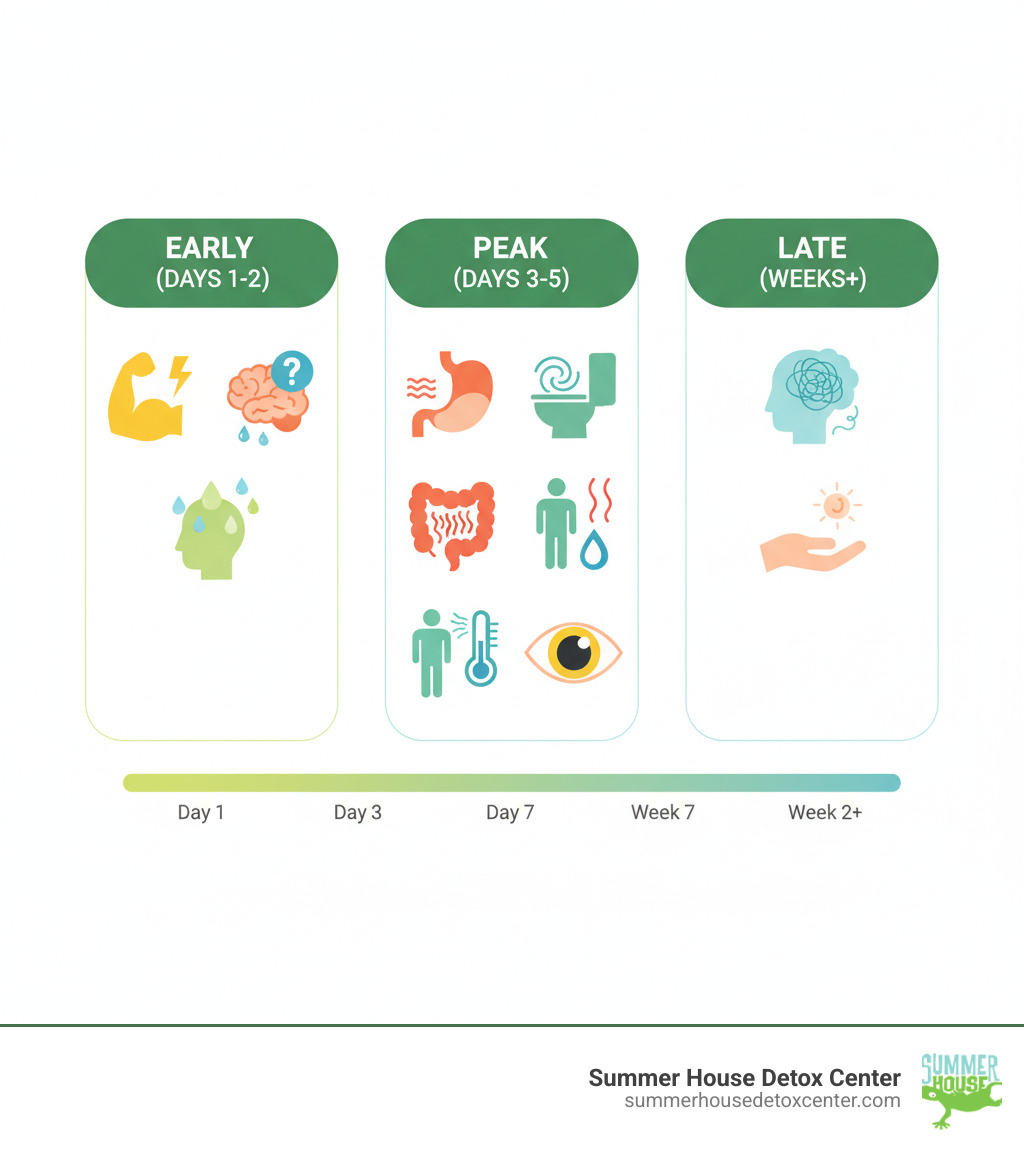The Opiate Withdrawal Timeline: From Onset to Resolution
When it comes to day 3 opiate withdrawal symptoms, individuals typically experience the peak of physical and psychological discomfort. This stage is often the most challenging.
Here’s a quick look at what to expect:
- Physical Symptoms: Intense nausea, vomiting, diarrhea, severe abdominal cramping, widespread muscle aches and pains, profound chills, profuse sweating, goosebumps (often called “cold turkey”), and dilated pupils.
- Psychological Symptoms: High levels of anxiety, extreme irritability, persistent insomnia, and very strong drug cravings.
This is a critical period in the withdrawal process.
Simple guide to day 3 opiate withdrawal symptoms terms:
- easing withdrawal symptoms from opiates
- does gabapentin help with opiate withdrawal symptoms
- opiate withdrawal symptoms
Facing opiate withdrawal is overwhelming. The fear of discomfort can feel like a trap, preventing a fresh start. Understanding the withdrawal stages, however, can reduce this fear and empower you to seek help.
Opiates alter brain chemistry, leading to physical dependence. When you stop using, your body reacts—this is withdrawal. While difficult, it’s a temporary process. The timeline varies based on the opiate type, duration of use, and your health, but a general pattern exists that can help you prepare.

At Summer House Detox Center, we know every journey is unique. Opiate withdrawal can last from days to weeks, depending on the opioid and usage history. For example, heroin withdrawal starts within 6-12 hours and lasts about five days, while withdrawal from longer-acting opioids like methadone may not start for days and can last 10-20 days. It’s a marathon, not a sprint, and we’re here to guide you. Learn more in our guide on How Long Does It Take to Withdraw From Opiates?.
Withdrawal severity depends on the drug, dosage, and duration of use (over six months often means more severe symptoms). Your overall physical and mental health are also key factors. That’s why a personalized detox approach, like the one at Summer House Detox Center, is so crucial. We assess all these elements to create the right plan for you. See our overview of Opiate Withdrawal Symptoms for more.
Early Withdrawal (Days 1-2)
The initial phase of opiate withdrawal often feels like a severe flu, kicking in within 6 to 24 hours after the last dose. Depending on the opiate, the onset varies; heroin withdrawal can start in 6-12 hours, while methadone withdrawal may not begin for around 30 hours.
During these first days, you might experience:
- Muscle aches
- Anxiety and agitation
- Insomnia
- Profuse sweating
- Runny nose and tearing eyes
- Frequent yawning
These symptoms are a sign that the healing process has begun.
Peak Withdrawal (Days 3-5)
This is where the storm truly rages. Days 3 to 5 are generally the most intense phase of opiate withdrawal. It’s when day 3 opiate withdrawal symptoms peak, bringing a cascade of physical and psychological challenges. For many, this is the hardest part, but it’s also a sign your body is working hard to cleanse itself.
The physical discomfort can be overwhelming, but remember, these symptoms are temporary and will subside.
Late & Post-Acute Withdrawal (PAWS)
After the acute physical symptoms fade, some individuals experience Post-Acute Withdrawal Syndrome (PAWS). These lingering symptoms can persist for weeks or months, primarily affecting mental and emotional well-being.
PAWS can manifest as:
- Psychological challenges: Mood swings, poor concentration, memory issues.
- Cravings: Intense urges to use, often triggered by stress.
- Depression: Persistent sadness or hopelessness.
- Protracted withdrawal: A prolonged state of anxiety and heightened stress reactivity, which can contribute to relapse.
PAWS can be challenging and requires ongoing support and coping strategies. For a comprehensive overview, the MedlinePlus Medical Encyclopedia on Opiate and Opioid Withdrawal is a valuable resource.
The Peak of the Storm: A Deep Dive into Day 3 Opiate Withdrawal Symptoms
If you’ve wondered what makes day 3 opiate withdrawal symptoms so brutal, you’re not alone. At Summer House Detox Center in Miami, we’ve guided countless individuals through this phase. Day 3 is often when the storm reaches its peak, as your body’s reaction to the absence of opioids hits full force.
Medical professionals use the Clinical Opiate Withdrawal Scale (COWS) to measure symptom intensity. A score of 25-36 is moderately severe, while a score above 37 is severe. On day 3, many people are in these higher ranges, explaining why the day feels so overwhelming.
Your body, accustomed to opioids, is now scrambling to function without them. This sudden change is why day 3 is often the hardest part of detox, but it’s also a sign of healing. We know these days feel endless, but they’re not. Our team at Summer House understands what you’re going through and is here to help you steer this time with comfort and support. Learn more in our article on Managing Withdrawal Symptoms: How Summer House Detox Center Helps You Through the Hardest Days.
Common Physical Day 3 Opiate Withdrawal Symptoms
On day 3, your body goes into overdrive to rebalance itself. It’s like having the worst flu of your life, but your body is the medicine, working hard to heal.
Gastrointestinal distress is a primary issue. Intense nausea, vomiting, severe stomach cramping, and unpredictable diarrhea are common and exhausting.
Muscle and bone pain settles deep in your body, making it nearly impossible to find a comfortable position.
Your body’s thermostat breaks, causing swings between profuse sweating and uncontrollable, bone-deep chills. In Miami’s humid climate, this adds another layer of discomfort.
Dehydration becomes a serious concern due to fluid loss from sweating, vomiting, and diarrhea. This is one of many reasons why medical supervision during withdrawal is so important.
While these symptoms are rarely life-threatening, they can lead to serious complications like severe dehydration and electrolyte imbalances if not managed professionally. Our article Is Opiate Withdrawal Deadly? provides important safety information.
Psychological Day 3 Opiate Withdrawal Symptoms
The physical symptoms are tough, but the psychological battle can be even more challenging as your brain struggles to function without opioids.
Intense cravings for opioids can feel overwhelming. These are not just thoughts but powerful biological urges for relief that feel urgent and immediate.
Severe anxiety can manifest as a constant state of panic, with a racing heart and a sense of impending doom that feels terrifyingly real.
Irritability and agitation are common, making you feel on edge and easily frustrated. Minor annoyances can trigger intense reactions.
Insomnia is frequent, leaving you physically drained but mentally wired and unable to get the rest your body desperately needs.
Dysphoria, a general sense of unease and an inability to feel pleasure, can cast a gray cloud over everything as your brain adjusts.
These psychological symptoms show how deeply opioids affect the brain. Recognizing these signs is a key step toward getting help. Our article on Signs of Opiate Addiction can help you understand these patterns better.
How to Safely Manage Withdrawal Symptoms

Facing opiate withdrawal, especially when day 3 opiate withdrawal symptoms are at their peak, is a journey no one should take alone. While the symptoms themselves are rarely fatal, complications like severe dehydration or the high risk of overdose upon relapse can be dangerous. This is why medical supervision during detox is a lifesaver, ensuring your safety and comfort.
When should you seek help? Always. Professional medical care is crucial for anyone experiencing or anticipating opiate withdrawal. Seek immediate medical attention for emergency signs like severe dehydration, chest pain, breathing trouble, seizures, or thoughts of self-harm. A critical danger of detoxing alone is the high risk of overdose upon relapse. After detox, tolerance drops significantly, making a previous dose potentially fatal. This tragic situation is common for those who attempt detox without professional support.
At Summer House Detox Center in Miami, Florida, we provide a safe, supportive environment for navigating withdrawal. We believe everyone deserves a comfortable and dignified detox. To learn who can benefit from our services, please visit: Who Needs Opiate Detox in Florida?.
Medical Interventions and Medications
Medical detox is the gold standard for managing opiate withdrawal. At Summer House Detox Center in Miami, FL, our medically supervised programs are designed to ease symptoms and keep you safe. Our experienced medical team uses FDA-approved medications and other interventions, tailoring treatment to your unique needs.
We use several tools to make your journey smoother. Buprenorphine (in Suboxone) can reduce withdrawal symptoms and cravings. Methadone is another option for managing withdrawal. For adrenaline-like symptoms (anxiety, sweating), medications like Alpha-2 Adrenergic Agonists (Clonidine and Lofexidine) can be effective. We also use GABA Analogues like Gabapentin to help with anxiety and pain. Beyond these, we provide targeted symptomatic relief, such as anti-nausea medications and over-the-counter pain relievers like ibuprofen for muscle aches.
All medications are given under strict medical supervision to ensure they are both effective and safe. Your comfort and well-being are our top priorities. For a deeper look, check out Which Medications Are Used in Opiate Detox?. Our comprehensive approach to Opiate Detox Treatment ensures you receive the best possible care.
Non-Pharmacological Coping Strategies
While medical interventions are vital, non-pharmacological strategies also play a huge role in your comfort and healing, working hand-in-hand with medication.
At Summer House Detox Center, we encourage several strategies to help you feel better:
- Hydration: It’s crucial to counteract fluid loss. We provide ample fluids, including water, electrolyte drinks, and broth, to prevent dehydration.
- Nutrition: Small, easy-to-digest meals and snacks help maintain strength. When solid food is too difficult, liquid nutritional supplements are a good alternative.
- Light Exercise: Gentle movement like short walks can ease restlessness and lift your mood. Listen to your body and don’t push yourself.
- Rest: We create a calm, quiet space to help you get the rest your body needs to heal. Our medical team can also help manage insomnia.
- Hot Baths or Showers: Many find that soaking in a warm bath or shower provides incredible relief from muscle aches and chills.
- Distraction Techniques: Engaging your mind can shift focus from discomfort and cravings. Watching movies, reading, or listening to music can help.
- Support Systems: Leaning on our compassionate staff, therapists, or loved ones is invaluable for lessening feelings of isolation and anxiety.
These professional measures are very different from unproven at-home detox kits. Trying to detox from opiates at home without medical supervision is dangerous and increases the risk of complications or relapse. Our article, Are At Home Opiate Detox Kits Safe?, explains why professional care is the safest choice.
Frequently Asked Questions about Opiate Withdrawal
We understand you have many questions about opiate withdrawal, especially its most challenging phases. Here are some common questions we hear at Summer House Detox Center, answered with clarity.
How long do the worst opiate withdrawal symptoms last?
Generally, the most intense opiate withdrawal symptoms, including the severe day 3 opiate withdrawal symptoms, last for about 3 to 5 days. This “peak withdrawal” is when physical symptoms like nausea, vomiting, and muscle aches are at their worst, along with significant psychological distress.
While this acute phase feels overwhelming, it is temporary. After day 5, symptoms gradually ease, though the exact timeline depends on the opioid used, duration of use, and your overall health. For a deeper medical understanding, the Opioid Withdrawal – StatPearls – NCBI Bookshelf offers valuable insights.
Can you die from opiate withdrawal?
This is a critical question. While opiate withdrawal itself is rarely fatal (unlike withdrawal from alcohol or benzodiazepines), the complications can be dangerous if not medically managed. Severe vomiting and diarrhea can lead to life-threatening dehydration and electrolyte imbalances, which strain the heart and other organs, especially in those with pre-existing health conditions.
The most significant danger is the high risk of a fatal overdose upon relapse. Tolerance drops quickly during detox, so a previous dose can become lethal. This is why medically supervised detox, like what we offer at Summer House Detox Center, is so crucial for your safety.
What helps with body aches from opiate withdrawal?
Body aches are a hallmark of opiate withdrawal, often felt as a deep, pervasive pain in muscles and bones. Fortunately, several strategies can provide relief.
Over-the-counter (OTC) pain relievers like ibuprofen can help, but always use them under medical guidance to ensure safety and avoid interactions with other medications. Many people find immense comfort in hot baths and showers, as the warmth soothes sore, tense muscles.
Topical analgesics (creams or patches) can provide localized relief. If you are able, gentle massage and stretching can also help relax tense muscles. It is also important to stay well-hydrated, as this supports overall body function and muscle health. Finally, getting as much rest as possible is essential for your body to heal and recover.
At Summer House Detox Center, we combine these comfort measures with medical interventions to ensure you experience the least possible discomfort from all withdrawal symptoms.
Finding Calm After the Storm: Your Path to Recovery in Florida
Making it through the worst of withdrawal—especially the challenging day 3 opiate withdrawal symptoms—is like weathering a hurricane. You’ve shown incredible strength. But the real work of rebuilding begins when the storm subsides.
Recovery is more than just getting through detox; it’s about building a new life. Detox clears the wreckage, but recovery is about rebuilding on a stronger foundation that can withstand future challenges.
That’s where choosing Florida for your recovery journey shines. Here in the Sunshine State, the warm climate and peaceful beaches create a natural healing environment. There’s something profoundly restorative about watching a Miami Beach sunrise as you begin a new chapter.
At Summer House Detox Center, we’ve seen countless individuals transition from the chaos of withdrawal to the calm of recovery. Our Miami facility is here to help you find who you are without substances defining your days.
Relapse prevention is about more than willpower; it’s about learning triggers, developing coping skills, and building a strong support network. Our staff, many in recovery themselves, understand this deeply. The importance of continued care cannot be overstated. Detox is the foundation, but ongoing treatment, therapy, and support groups are what build a lasting recovery. We connect you with these vital resources to support your long-term sobriety.
Florida offers unique advantages for recovery. Why Choose Florida for Opiate Detox? explores how our state’s healing environment and excellent treatment facilities create an ideal setting for change. Distance from old triggers can be powerful for breaking established patterns.
Our personalized medical detox approach in Miami recognizes that every journey is unique. We tailor our Detox Services: Opiate Detox to meet you where you are, providing the specific support and medical care you need to feel safe and comfortable.
The path from withdrawal to recovery isn’t always straight. But with proper support, medical care, and a commitment to your healing, you can build a life that’s not just free from opioids—but genuinely fulfilling and joyful.
If you’re ready to take that courageous first step, we’re here to walk alongside you. Recovery is possible, and it starts with a single decision to reach out for help.


